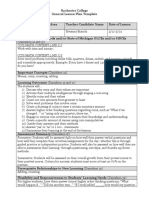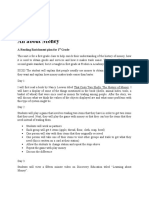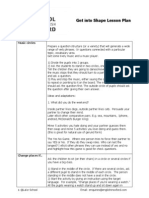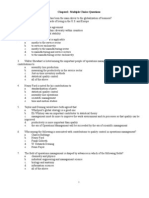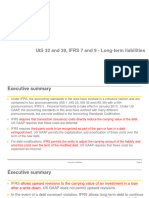An Introduction To Money Its Origin, History, and Functions
An Introduction To Money Its Origin, History, and Functions
Uploaded by
jodes_jmCopyright:
Available Formats
An Introduction To Money Its Origin, History, and Functions
An Introduction To Money Its Origin, History, and Functions
Uploaded by
jodes_jmOriginal Description:
Original Title
Copyright
Available Formats
Share this document
Did you find this document useful?
Is this content inappropriate?
Copyright:
Available Formats
An Introduction To Money Its Origin, History, and Functions
An Introduction To Money Its Origin, History, and Functions
Uploaded by
jodes_jmCopyright:
Available Formats
Grades 2-3 Lesson 1
AN INTRODUCTION TO MONEY Its Origin, History, and Functions
Rationale: This lesson is intended for elementary students in second through third grades during a forty minute time period. The lesson teaches students the concept of the barter system, early forms of money, and the purpose of money. Each activity deals with the introduction to money. The activities rely on a variety of interactive and visual formats designed to be interesting and fun. Lesson Objectives: Students will be able to: Describe the bartering system. Describe early forms of money. Describe the purposes of money o medium of exchange o stores value o places a value. Materials: Stickers or popsicle sticks A scale balance Pencils Worksheet
Setting the Stage: Background Builder #1: Show students pictures of coins and/or actual coins. Review values. Remind students that our government makes (prints and mints) our money and it is regulated. Background Builder #2: Pass out small items (popsicle sticks, pencils, or stickers) randomly to students. Then try to trade/barter with a different item. Reinforce that people frequently trade items they have for items they want.
TD Bank WOW! Zone
Grades 2-3/Lesson 1
State the Objective: tell the students what they will be able to do upon conclusion of the lesson. Before the end of this lesson, you will be able to tell me what bartering and trading are. You will also be able to tell me why people created money. Finally, you will be able to explain why saving is important. You should also decide that its a good idea to save a certain amount every time you receive money. The Lesson Procedure: Ask students the following question: How do people get money? Money is given in return for a service or time. o Teachers earn money. o Bankers earn money. o Professional athletes earn money. o The person (lawn service) who cuts your grass may earn money. o A hairdresser earns money. o If you receive an allowance, you probably do some chores in exchange for it. This is earning money for the time you have spent doing something such as cleaning your room. Ask students the following question: What do you use money for? Elicit responses such as to buy things or to pay for services. Most likely all answers can be classified into those two groups. For example: Paying for a vacation involves paying for the hotel, plane tickets, amusement park rides, etc. Ask students the following question, What do you do with your allowance or other money you receive? Elicit answers from the students such as, Save it or buy something with it. If you are saving money for something special such as a scooter, you know how much money you will need to buy it. Money stores value so that you can keep it for a long time without it losing value. Next, ask students to name some kinds of money: penny, nickel, dime, etc. The barter system and the origin of money: There was a time before money existed. People traded things for things. Refer to the story of Jack and the Beanstalk. Jack traded the family cow for some bean seeds. Jacks mother was upset because it was an unfair trade. A cow was worth much more than a couple of bean seeds. If youve ever traded something in your lunch box for something in someone elses, youve used the barter system. Trading had many problems so people set rules. They would trade by weight. Use the scale balance to demonstrate trading pencils for stickers in order to TD Bank WOW! Zone 2 Grades 2-3/Lesson 1
illustrate how trading by weight worked. In lieu of having a scale balance, assign classroom items a particular price: a chalkboard eraser may cost 3 pencils, a desk may be 100 pencils, etc. Later people started to use more valuable things for trading: metals such as silver and gold. Kings liked this because the metal could be stamped or minted with their face on it. Now everyone in the kingdom would recognize this person as king. Also, it was easy to make lots of coins of the same type and weight. Today we have price tags to tell us how much something costs. Objects have a monetary value. This value is the same for everyone: o If I want to buy a Game Boy, it costs about $60. o If you want to buy a Game Boy, it costs about $60. o If Michael Jordan wants one, it also costs him about $60. Lets look at how money buys items today. Use Worksheet 1: Toys With Prices. Closing the Lesson: Review the concepts of bartering and why people use money. You may choose to end the lesson with a technique from Ways to End and Review Lessons on the following page.
National Council of Teachers of Mathematics Principles and Standards for School Mathematics, 2000. Number and Operations (Students will) Understand numbers, ways of representing numbers, relationships among numbers, and number systems. Algebra (Students will) Understand patterns, relations, and functions. Communication (Students will) Organize and consolidate their mathematical thinking through communication. Connections (Students will) Recognize and use connections among mathematical ideas. Representation (Students will) Create and use representations to organize, record, and communicate mathematical ideas.
TD Bank WOW! Zone
Grades 2-3/Lesson 1
Ways to End and Review Lessons Quizbowl: Separate the students into two teams and ask questions related to the lesson. For example: What does the word barter mean? Jigsaw: Jigsaw students into three groups and assign each a specific question from the lesson to answer together, with one person from each team acting as the spokesperson. Sample questions: What do you use money for? What are some problems with the barter system? What does it mean when we say money stores its value? Why is the value of money important? Misinformation: Quote information from the days lesson purposely erroneous. Call on various students to restate the information correctly. Whats left out? Supply students with statements that have some information missing. This can be done orally or it can be done on a blackboard. Ask students to provide the missing information. Pair and Share: Group students into pairs and ask each pair to exchange two or three new things learned during the days lesson. Call on select pairs to share with the whole class what has been learned.
TD Bank WOW! Zone
Grades 2-3/Lesson 1
Money Trivia
The following are miscellaneous facts about money that you may wish to include in your presentation. They may also be helpful in answering questions the students have:
About 3,500 years ago Cowrie shells (small seashells) were used for money in China, Africa, and Australia. The Yap Islanders in the Pacific Ocean used large stone disks about 13 feet across for money. (This is about as long as a chalkboard.) China used bricks of tealeaves for money until just 100 years ago. The Roman soldiers earned their wages in an allowance of salt, called a salarium. This is where the word salary originates. Coins last about 20 or 30 years in circulation before they are worn out. $1, $5, $10, and $20 bills last about 3 months. Then they are shredded and burned by special people in the government. $50 and $100 bills can last for 3 or 4 years.
TD Bank WOW! Zone
Grades 2-3/Lesson 1
An Introduction to Money Worksheet #1
Name_________________
Directions: Color the most expensive item green. Color the least expensive item purple.
TD Bank WOW! Zone
Grades 2-3/Lesson 1
You might also like
- 2Document3 pages2bea75% (4)
- Maths Unit PlanDocument5 pagesMaths Unit Planapi-466313157No ratings yet
- Template For Research ProposalDocument3 pagesTemplate For Research Proposaljodes_jm100% (2)
- Assignment 1 - Tiered Lesson With AnnotationsDocument13 pagesAssignment 1 - Tiered Lesson With AnnotationsStephNo ratings yet
- Math Lesson Plan-WeeblyDocument5 pagesMath Lesson Plan-Weeblyapi-489828484No ratings yet
- Math Methods Lesson PlanDocument3 pagesMath Methods Lesson Planapi-249226394No ratings yet
- Lesson Plan Characteristics and Functions of MoneyDocument6 pagesLesson Plan Characteristics and Functions of Moneyapi-350452250No ratings yet
- Money 10Document10 pagesMoney 10Antwayne Youcantstopmaprogress HardieNo ratings yet
- Lesson One-MathDocument5 pagesLesson One-Mathapi-254944388No ratings yet
- I. Lesson Plan Overview and DescriptionDocument6 pagesI. Lesson Plan Overview and Descriptionapi-283247632No ratings yet
- EDEL453 Spring2013 DeniseCROSBY Unit 1 Economics Day 2Document7 pagesEDEL453 Spring2013 DeniseCROSBY Unit 1 Economics Day 2Denise CrosbyNo ratings yet
- STEM 433/533 Lesson Planning Template: Abigail Sisk 1 Value of CoinsDocument5 pagesSTEM 433/533 Lesson Planning Template: Abigail Sisk 1 Value of Coinsapi-584319081No ratings yet
- Actividad 1 (Introduccion Al Dinero)Document29 pagesActividad 1 (Introduccion Al Dinero)Fernando LermaNo ratings yet
- HistoryDocument3 pagesHistoryapi-241819505No ratings yet
- DimesDocument2 pagesDimesapi-350421404No ratings yet
- Ued496mania B Artifacte Unitstudy EconomicsDocument18 pagesUed496mania B Artifacte Unitstudy Economicsapi-266311505No ratings yet
- Activity For Currency For Pre-SchoolDocument7 pagesActivity For Currency For Pre-SchoolAbisola AwariNo ratings yet
- EDEL453 Spring2013 MichaelFEHER Economics Day1Document3 pagesEDEL453 Spring2013 MichaelFEHER Economics Day1mf150032No ratings yet
- Mathlessonplan 1Document2 pagesMathlessonplan 1api-340407648No ratings yet
- Lesson Plan Form Revised 8 22 11-1Document3 pagesLesson Plan Form Revised 8 22 11-1api-242113389No ratings yet
- Social Studies Lesson PlanDocument11 pagesSocial Studies Lesson Planapi-349363475No ratings yet
- Assessment 2 Unit Planner Math 2017Document7 pagesAssessment 2 Unit Planner Math 2017api-361486507No ratings yet
- Miss. Hawk'S Money Madness Unit 2 Grade: Resources Used Mcgraw Hill-My Math-2 Grade Section 8.1-8.3Document42 pagesMiss. Hawk'S Money Madness Unit 2 Grade: Resources Used Mcgraw Hill-My Math-2 Grade Section 8.1-8.3api-283620433No ratings yet
- Rachels Alexis BlueprintfinalDocument15 pagesRachels Alexis Blueprintfinalapi-286060600No ratings yet
- Ed 300-Lesson Plan 1Document2 pagesEd 300-Lesson Plan 1api-275756316No ratings yet
- American Coins FakeDocument5 pagesAmerican Coins FakerfwwritesNo ratings yet
- Unit Plan 5Document3 pagesUnit Plan 5api-284320595No ratings yet
- Unit Map 12142015Document4 pagesUnit Map 12142015api-302574975No ratings yet
- Educ420 Lesson 5 Math-MoneyDocument3 pagesEduc420 Lesson 5 Math-Moneyapi-199099982No ratings yet
- Lessonplan Know How To Count and Use Us Coins and CurrencyDocument5 pagesLessonplan Know How To Count and Use Us Coins and Currencymolive99No ratings yet
- Isl and CapstoneDocument6 pagesIsl and Capstoneapi-348627392No ratings yet
- Stem 433 - Final Lesson Plan - Cargen TaylorDocument5 pagesStem 433 - Final Lesson Plan - Cargen Taylorapi-644852511No ratings yet
- Money Circle Theme 1 Lesson 1Document7 pagesMoney Circle Theme 1 Lesson 1SamraNo ratings yet
- 6e Model PlanDocument4 pages6e Model Planapi-278538540No ratings yet
- 23 Ed Teaching Techniques and Activities For LessonsDocument4 pages23 Ed Teaching Techniques and Activities For Lessonsapi-239094488No ratings yet
- Grade 2 Lesson Plan - AigDocument2 pagesGrade 2 Lesson Plan - Aigapi-297802969No ratings yet
- Educ 339 Lesson Plan 1Document5 pagesEduc 339 Lesson Plan 1api-293758594No ratings yet
- Final Lesson PlanDocument8 pagesFinal Lesson Planapi-341077593No ratings yet
- All About Money: A Reading Enrichment Plan For 1 GradeDocument2 pagesAll About Money: A Reading Enrichment Plan For 1 GradedottiebarrowNo ratings yet
- ED 305 Calvin College Lesson Planning Form: Ccss - Math.Content.5.G.B.3Document5 pagesED 305 Calvin College Lesson Planning Form: Ccss - Math.Content.5.G.B.3api-314250067No ratings yet
- Money Egss: Topic: Economics - Money Grade: 2 Teacher: Miss Quanrud Iowa Core: Social Studies - EconomicsDocument5 pagesMoney Egss: Topic: Economics - Money Grade: 2 Teacher: Miss Quanrud Iowa Core: Social Studies - EconomicsMarcus BatesNo ratings yet
- Literacy Prop Box - DanaDocument3 pagesLiteracy Prop Box - Danaapi-313262052No ratings yet
- What Is Money?: F R B PDocument15 pagesWhat Is Money?: F R B PVinod ZingadeNo ratings yet
- Lesson PlanDocument3 pagesLesson Planapi-318236618No ratings yet
- ABC Economic LiteracyDocument132 pagesABC Economic LiteracyDanicaTasicNo ratings yet
- Money Recognition Sped Lesson Plan 2022Document3 pagesMoney Recognition Sped Lesson Plan 2022api-614334487No ratings yet
- Unit 3 - ListeningDocument10 pagesUnit 3 - ListeningTUYET LE ANH0% (1)
- Math Lesson Plan: - Grade 1 - Lesson Length 3-4 DaysDocument1 pageMath Lesson Plan: - Grade 1 - Lesson Length 3-4 Daysapi-245236838No ratings yet
- Topic 7 Money PDFDocument28 pagesTopic 7 Money PDFnickzenNo ratings yet
- Lesson Plan Outline-Day 3Document3 pagesLesson Plan Outline-Day 3api-281198656No ratings yet
- Seton Hill University Lesson Plan Template: Name Subject Grade Level Date/DurationDocument6 pagesSeton Hill University Lesson Plan Template: Name Subject Grade Level Date/Durationapi-266496943No ratings yet
- Lesson Plan FinalDocument11 pagesLesson Plan Finalapi-241619704No ratings yet
- Get Into Shape Lesson Plan: Music CirclesDocument4 pagesGet Into Shape Lesson Plan: Music CircleslakeschoolNo ratings yet
- Model Lesson Plan: Social StudiesDocument5 pagesModel Lesson Plan: Social StudiesIna GrigorNo ratings yet
- Opportunity Cost Mini LessonsDocument39 pagesOpportunity Cost Mini Lessonsapi-533796260No ratings yet
- 2 Grade Inquiry-Based Lesson South Africa vs. Slaton, TXDocument31 pages2 Grade Inquiry-Based Lesson South Africa vs. Slaton, TXSamantha MelvinNo ratings yet
- Finance Is Fun!: Maths and MoneyDocument7 pagesFinance Is Fun!: Maths and MoneywendyNo ratings yet
- Counting Money Lesson PlanDocument8 pagesCounting Money Lesson Planapi-217236354No ratings yet
- Alexander Who Used To Be Rich Last SundayDocument17 pagesAlexander Who Used To Be Rich Last Sundayjenni salazarNo ratings yet
- Task 1 - Creating A Service GroupDocument1 pageTask 1 - Creating A Service Groupjodes_jmNo ratings yet
- Elearning Methodology ToolkitDocument45 pagesElearning Methodology Toolkitjodes_jmNo ratings yet
- The Ultimate e Learning ChecklistDocument2 pagesThe Ultimate e Learning Checklistjodes_jmNo ratings yet
- 2003 Ethanol Fact BookDocument56 pages2003 Ethanol Fact Bookjodes_jmNo ratings yet
- Online Technical Writing Task Analysis and Task-Oriented DocumentationDocument8 pagesOnline Technical Writing Task Analysis and Task-Oriented Documentationjodes_jmNo ratings yet
- Editing Your Writing For Content, Coherence and CohesionDocument4 pagesEditing Your Writing For Content, Coherence and Cohesionjodes_jmNo ratings yet
- 2003 Ethanol Fact BookDocument56 pages2003 Ethanol Fact Bookjodes_jmNo ratings yet
- Mayo, Maslow, Herzberg Taylor NotesDocument7 pagesMayo, Maslow, Herzberg Taylor Notesjodes_jmNo ratings yet
- August 2007: Activity ScheduleDocument2 pagesAugust 2007: Activity Schedulejodes_jmNo ratings yet
- Demand and Supply New HandoutDocument12 pagesDemand and Supply New Handoutjodes_jmNo ratings yet
- Time Sheet: Who: Interact Club Sponsored by The Rotary of QuincyDocument3 pagesTime Sheet: Who: Interact Club Sponsored by The Rotary of Quincyjodes_jmNo ratings yet
- Capstone Lesson1Document13 pagesCapstone Lesson1jodes_jmNo ratings yet
- Chapter 1 QuizDocument7 pagesChapter 1 QuizRichie Sơn NguyễnNo ratings yet
- Price Ceilings and FloorsDocument7 pagesPrice Ceilings and Floorsjodes_jm100% (1)
- Rubric For Oral PresentationDocument1 pageRubric For Oral Presentationjodes_jmNo ratings yet
- Rubric For Oral PresentationDocument1 pageRubric For Oral Presentationjodes_jm100% (1)
- SimulationDocument1 pageSimulationjodes_jmNo ratings yet
- CPICalculationDocument1 pageCPICalculationjodes_jmNo ratings yet
- Rupee ChartDocument1 pageRupee ChartRehan SadiqNo ratings yet
- Chapter 25 (10) Capital Investment Analysis: ObjectivesDocument40 pagesChapter 25 (10) Capital Investment Analysis: ObjectivesJames BarzoNo ratings yet
- Loan Proposal Premi Itta UdhyogDocument11 pagesLoan Proposal Premi Itta UdhyogSudhakaar ShakyaNo ratings yet
- ReceiptDocument1 pageReceiptdevi yantiNo ratings yet
- GBERMIC - Module 11Document8 pagesGBERMIC - Module 11Paolo Niel ArenasNo ratings yet
- Ravindra BhaiDocument45 pagesRavindra BhaiRavindra PatelNo ratings yet
- Money Laundering Prevention Act 2012-2015Document25 pagesMoney Laundering Prevention Act 2012-2015gehapi3428No ratings yet
- Review of The Subject International EconomicsDocument64 pagesReview of The Subject International EconomicsPhan Hà TrangNo ratings yet
- Chapter 9: Mathematics of FinanceDocument55 pagesChapter 9: Mathematics of FinanceQuang PHAMNo ratings yet
- Unit 2 - Time Value of MoneyDocument70 pagesUnit 2 - Time Value of MoneyNolan TitusNo ratings yet
- 2023 EwtDocument4 pages2023 Ewtdivine mercyNo ratings yet
- Ap MacroeconomicsDocument40 pagesAp Macroeconomicscassandranguyen0702No ratings yet
- Consolidation Theories, Push-Down Accounting, and Corporate Joint VenturesDocument27 pagesConsolidation Theories, Push-Down Accounting, and Corporate Joint VenturesvionaNo ratings yet
- Training The Street DCFDocument2 pagesTraining The Street DCFantoine.deloisonNo ratings yet
- IAS 32 39 IFRS 7 9 Long Term LiabilitiesDocument48 pagesIAS 32 39 IFRS 7 9 Long Term LiabilitiesSamer BrownNo ratings yet
- The Partnership of Sewell Grange and Jones Has Just CompletedDocument1 pageThe Partnership of Sewell Grange and Jones Has Just CompletedBube KachevskaNo ratings yet
- FR Group Lesson 1Document16 pagesFR Group Lesson 1Adebola OguntayoNo ratings yet
- Ghss Koduvayur Higher Secondary Model Examination 2011 Accountancy With Computerised AccountingDocument3 pagesGhss Koduvayur Higher Secondary Model Examination 2011 Accountancy With Computerised Accountingsharathk916No ratings yet
- Do RememberDocument6 pagesDo RememberRohit KariwalaNo ratings yet
- NPS LeafletDocument2 pagesNPS LeafletMOHIT GUPTA jiNo ratings yet
- Fundamentals of Accountancy, Business and Management 1Document7 pagesFundamentals of Accountancy, Business and Management 1Yannah LongalongNo ratings yet
- Foreign Investment PolicyDocument16 pagesForeign Investment PolicyNooraYasminNo ratings yet
- Final MathDocument5 pagesFinal MathBrendan Lewis DelgadoNo ratings yet
- Sahaj Arora, 12-C, 12122, Economics Project, Money MultiplierDocument11 pagesSahaj Arora, 12-C, 12122, Economics Project, Money MultiplierSahajNo ratings yet
- DB Emerging Markets Credit DerivativesDocument54 pagesDB Emerging Markets Credit DerivativesThomasNo ratings yet
- Giáo Trình International Finance - FinalDocument188 pagesGiáo Trình International Finance - FinalHải LongNo ratings yet
- Financial Environment PDFDocument11 pagesFinancial Environment PDFnira_11075% (4)
- KOREKSI Kel.9 Oleh Kelompok 2Document9 pagesKOREKSI Kel.9 Oleh Kelompok 2Yoananda SyarafinaNo ratings yet
- IFRS Differences in Accounting 17Document7 pagesIFRS Differences in Accounting 17Silvia alfonsNo ratings yet






























